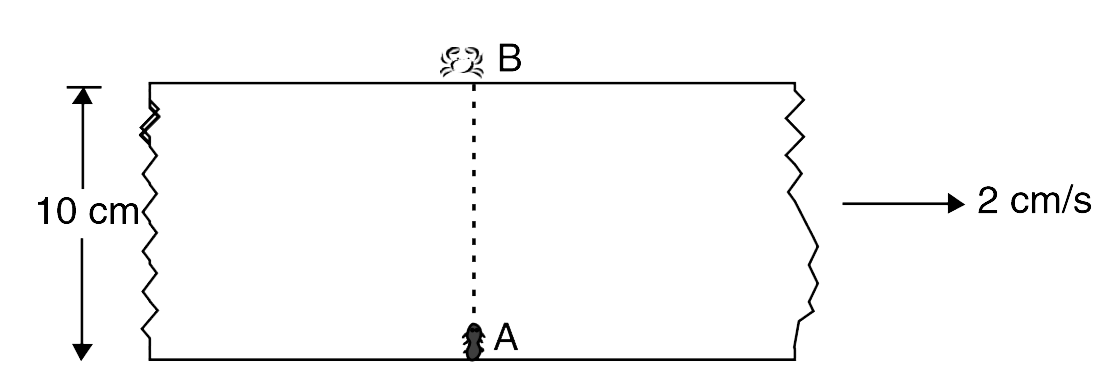A point moves along of radius R =10 cm. the path length depends on time according to L=At, where A=1 m/sec. At 5 second after the start of movement.
v=1 m/s
ω=1 rad/s
a=10m/s2
θ=50 rad.
The correct Answer is:ACD
L=t
v=dLdt=1
v=ωr=ω×0.1
ω=10rad/s
a=ω2r=100×0.1=10m/s2
θ=ωt=10×5=50rad.
Topper's Solved these Questions
- BOOK - BANSALCHAPTER - TEST PAPERSEXERCISE - PHYSICS PART (A)32videos
TEST PAPERS
- BOOK - BANSALCHAPTER - TEST PAPERSEXERCISE - PHYSICS PART (B)3videos
TEST PAPERS
- BOOK - BANSALCHAPTER - TEST PAPERSEXERCISE - PHYSICS PART- C4videos
TEST PAPERS
- BOOK - BANSALCHAPTER - SEMICONDUCTORSEXERCISE - CBSE Question32videos
SEMICONDUCTORS
Similar Questions
A particle lis constrained to move in a circular path of radius r = 6m. Its velocity varies with time according to the relation v = 2t (m/s). Determine its
(i) centripetal acceleration,
(ii) tangential acceleration,
(iii) instantaneous acceleration at (a) t = 0 sec. and
(b) t = 3 sec.View SolutionThe position of a particle moving along x-axis depends on time according to the equation x=at2+bt3, where x is in metre and t is in sec. What are the units and dimensions of a and b : what do they represent?
View Solution
Knowledge Check
- Question 1 - Select One
A particle of mass m is moving on a circular path of radius r . Centripetal acceleration of the particle or radius r . Centripetal acceleration of the particle depends on time t according to relation ac=kt2 . What power is delievered to the particle ?
AmrktBmrkt2Cmr2ktDzero - Question 2 - Select One
A point moves along a circle with velocity v = at where a 0.5 m/sec2. Then the total acceleration of the point at the moment when it covered (1/10) th of the circle after beginning of motion -
A0.5m/sec2B0.6m/sec2C0.7m/sec2D0.8m/sec2 - Question 3 - Select One
An electron moves along a circular path of radius 10 cm. If the centripetal acceleration is 4×1011m/s2 , then its linear speed is
A0.5×105m/sB105m/sC2×105m/sD3×105m/s
A paricle of mass m moves along a circle of radius R with a normal acceleration varying with time as wn=at2, where a is a constant. Find the time dependence of the power developed by all the forces acting on the particle, and the mean value of this power averaged over the first t seconds after the beginning of motion.
View Solutionlong piece of paper is10 cm wide and is moving uniformly along its length with a velocity of 2cm/s. An ant starts moving on the paper from point A and moves uniformly with respect to the paper. A spider was located exactly opposite to the ant just outside the paper at point B at the instant the ant started to move on the paper. The spider, without moving itself, was able to grab the ant 5 second after it (the ant) started to move. Find the speed of ant relative to the paper.
 View Solution
View SolutionA point moves along a circle having a radius 20cm with a constant tangential acceleration 5cm/s2. How much time (in sec) is needed after motion begins for the normal acceleration of the point to be equal to tangential acceleration?
View SolutionA particle moves along an arc of a circle of radius R according to the law l=asinωt, where l is the displacement from the initial position measured along the arc, and a and ω are constants. Assuming R=1.00m, a=0.80m, and ω=2.00rad/s, find:
(a) the magnitude of the total acceleration of the particle at the points l=0 and l=±a,
(b) the minimum value of the total acceleration wmin and the corresponding displacement lm.View SolutionA particle starts from the origin and moves along a stright line If the velocity of the particle at time t seconds 10t cm/s then find the distance traversed during fist seconds after the start.
View Solution

